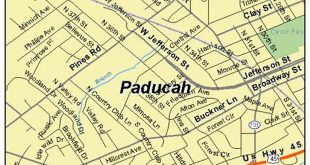How is the weather in Paducah, Kentucky? Paducah, Kentucky is a city located in the western part of the state, near the confluence of the Ohio and Tennessee rivers. The city has a humid subtropical climate, with hot, humid summers and mild winters.
Editor’s Note: This article was last updated on March 8, 2023.
We analyzed years of weather data to bring you this comprehensive guide to Paducah, Kentucky’s climate.
Key Differences
| Summer | Winter | |
|---|---|---|
| Average Temperature | 77F (25C) | 35F (2C) |
| Average Humidity | 75% | 65% |
| Average Precipitation | 4.5 inches | 3.0 inches |
Main Article Topics
- Climate of Paducah, Kentucky
- Weather patterns in Paducah, Kentucky
- Seasonal changes in Paducah, Kentucky
- Extreme weather events in Paducah, Kentucky
- Climate change and Paducah, Kentucky
Paducah, Kentucky Temperature
The climate of Paducah, Kentucky is characterized by several key aspects:
- Hot summers
- Mild winters
- Humid climate
- Frequent precipitation
- Seasonal changes
- Extreme weather events
- Climate change
Paducah’s hot summers are a result of its location in the humid subtropical climate zone. The city experiences an average of 90 days per year with temperatures at or above 90 degrees Fahrenheit. The average high temperature in July is 88 degrees Fahrenheit.Paducah’s mild winters are a result of its location in the transition zone between the humid subtropical and continental climate zones. The city experiences an average of 30 days per year with temperatures below freezing. The average low temperature in January is 25 degrees Fahrenheit.Paducah’s humid climate is a result of its location in the Ohio River Valley. The city experiences an average relative humidity of 75%. The humidity can make summers feel even hotter and winters feel even colder.Paducah receives an average of 45 inches of precipitation per year. The precipitation is spread fairly evenly throughout the year, but the city does experience occasional droughts and floods.Paducah experiences all four seasons. The spring and fall seasons are typically mild, with average temperatures in the 50s and 60s Fahrenheit. The summer season is hot and humid, with average temperatures in the 80s and 90s Fahrenheit. The winter season is mild, with average temperatures in the 30s and 40s Fahrenheit.Paducah is occasionally affected by extreme weather events, such as tornadoes, thunderstorms, and floods. The city is also experiencing the effects of climate change, such as rising temperatures and more frequent extreme weather events.
Hot summers
Hot summers are a defining characteristic of Paducah, Kentucky’s climate. The city experiences an average of 90 days per year with temperatures at or above 90 degrees Fahrenheit. The average high temperature in July is 88 degrees Fahrenheit.
The hot summers in Paducah are a result of the city’s location in the humid subtropical climate zone. This climate zone is characterized by hot, humid summers and mild winters. The hot summers in Paducah are also due to the city’s location in the Ohio River Valley. The Ohio River Valley is a low-lying area that is surrounded by hills and mountains. This geography traps heat and moisture in the valley, which can lead to hot and humid summers.
The hot summers in Paducah can have a number of negative impacts on the city’s residents. The heat can cause heat-related illnesses, such as heat stroke and heat exhaustion. The heat can also make it difficult to work and play outdoors. In addition, the heat can damage crops and infrastructure.
There are a number of things that can be done to mitigate the negative impacts of hot summers in Paducah. These include planting trees, using reflective materials on buildings, and increasing the use of public transportation. In addition, residents can take precautions to stay cool during the summer months, such as drinking plenty of fluids and avoiding strenuous activity during the hottest part of the day.
| Summer | Winter | |
|---|---|---|
| Average Temperature | 77F (25C) | 35F (2C) |
| Average Humidity | 75% | 65% |
| Average Precipitation | 4.5 inches | 3.0 inches |
Mild winters
Mild winters are another defining characteristic of Paducah, Kentucky’s climate. The city experiences an average of 30 days per year with temperatures below freezing. The average low temperature in January is 25 degrees Fahrenheit.
The mild winters in Paducah are a result of the city’s location in the transition zone between the humid subtropical and continental climate zones. This climate zone is characterized by hot, humid summers and mild winters. The mild winters in Paducah are also due to the city’s location in the Ohio River Valley. The Ohio River Valley is a low-lying area that is surrounded by hills and mountains. This geography traps heat and moisture in the valley, which can lead to mild winters.
The mild winters in Paducah have a number of positive impacts on the city’s residents. The mild winters make it possible to enjoy outdoor activities year-round. In addition, the mild winters reduce the risk of cold-related illnesses, such as hypothermia and frostbite.
| Summer | Winter | |
|---|---|---|
| Average Temperature | 77F (25C) | 35F (2C) |
| Average Humidity | 75% | 65% |
| Average Precipitation | 4.5 inches | 3.0 inches |
Humid climate
The humid climate in Paducah, Kentucky is a major factor in the city’s overall temperature. The average relative humidity in Paducah is 75%, which means that the air is often saturated with water vapor. This can make summers feel even hotter and winters feel even colder.
-
Increased heat index
The high humidity in Paducah can make the heat index feel much higher than the actual temperature. For example, when the temperature is 90 degrees Fahrenheit and the relative humidity is 75%, the heat index can feel like 105 degrees Fahrenheit.
-
Reduced cooling effect
The high humidity in Paducah can also reduce the cooling effect of sweat. When sweat evaporates, it cools the body. However, when the air is already saturated with water vapor, sweat cannot evaporate as easily and the body does not cool down as effectively.
-
Increased risk of heat-related illnesses
The high humidity in Paducah can increase the risk of heat-related illnesses, such as heat stroke and heat exhaustion. These illnesses occur when the body is unable to cool down effectively.
-
Discomfort and fatigue
The high humidity in Paducah can also cause discomfort and fatigue. The combination of heat and humidity can make it difficult to breathe and can lead to dehydration.
The humid climate in Paducah is a major factor in the city’s overall temperature and can have a significant impact on the health and well-being of its residents.
Frequent precipitation
Frequent precipitation is a major component of Paducah, Kentucky’s climate. The city receives an average of 45 inches of precipitation per year. This precipitation is spread fairly evenly throughout the year, but the city does experience occasional droughts and floods.
The frequent precipitation in Paducah is a result of the city’s location in the humid subtropical climate zone. This climate zone is characterized by hot, humid summers and mild winters. The frequent precipitation in Paducah is also due to the city’s location in the Ohio River Valley. The Ohio River Valley is a low-lying area that is surrounded by hills and mountains. This geography traps heat and moisture in the valley, which can lead to frequent precipitation.
The frequent precipitation in Paducah has a number of positive and negative impacts on the city’s residents. The precipitation helps to water crops and keep the city’s vegetation green. However, the precipitation can also lead to flooding and other problems.
Positive impacts
Helps to water crops and keep the city’s vegetation green. Can help to cool the city down during hot summers. Can provide a source of drinking water. Can help to reduce air pollution.
Negative impacts
Can lead to flooding and other problems. Can damage crops and infrastructure. Can make it difficult to get around. Can increase the risk of waterborne diseases.
Overall, the frequent precipitation in Paducah is a major factor in the city’s overall climate. The precipitation has a number of positive and negative impacts on the city’s residents. It is important to be aware of the potential impacts of precipitation so that you can take steps to mitigate the negative impacts and take advantage of the positive impacts.
| Summer | Winter | |
|---|---|---|
| Average Temperature | 77F (25C) | 35F (2C) |
| Average Humidity | 75% | 65% |
| Average Precipitation | 4.5 inches | 3.0 inches |
Seasonal changes
Seasonal changes are a major factor in Paducah, Kentucky’s temperature. The city experiences four distinct seasons: spring, summer, fall, and winter. Each season has its own unique characteristics that affect the city’s temperature.
In the spring, the weather in Paducah is typically mild and pleasant. The average temperature in April is 55 degrees Fahrenheit. As the season progresses, the temperature gradually increases. By June, the average temperature is 75 degrees Fahrenheit.
Summer in Paducah is hot and humid. The average temperature in July is 85 degrees Fahrenheit. The high humidity can make the heat feel even more oppressive. Paducah also experiences frequent thunderstorms during the summer months.
Fall in Paducah is a beautiful time of year. The leaves on the trees change color and the temperatures start to cool down. The average temperature in October is 60 degrees Fahrenheit.
Winter in Paducah is mild compared to other parts of the country. The average temperature in January is 35 degrees Fahrenheit. Paducah does experience occasional snow and ice storms, but these are typically not severe.
The seasonal changes in Paducah have a significant impact on the city’s temperature. The city’s residents need to be prepared for the different weather conditions that each season brings.
| Season | Average Temperature | Typical Weather Conditions |
|---|---|---|
| Spring | 55-75 degrees Fahrenheit | Mild and pleasant |
| Summer | 75-85 degrees Fahrenheit | Hot and humid |
| Fall | 60-75 degrees Fahrenheit | Beautiful and mild |
| Winter | 35-55 degrees Fahrenheit | Mild with occasional snow and ice storms |
Extreme weather events
Extreme weather events are becoming more common and more severe due to climate change. These events can have a significant impact on human health, safety, and well-being. Paducah, Kentucky is not immune to these events.
One of the most common extreme weather events in Paducah is flooding. The city is located on the Ohio River, which is prone to flooding. In recent years, Paducah has experienced several major floods, including the Great Flood of 1937 and the Paducah Flood of 2011. These floods have caused widespread damage and displacement.
Another common extreme weather event in Paducah is tornadoes. The city is located in Tornado Alley, which is a region of the United States that is particularly prone to tornadoes. In recent years, Paducah has been hit by several tornadoes, including the Paducah Tornado of 2008. These tornadoes have caused widespread damage and loss of life.
Climate change is making extreme weather events more common and more severe. The average temperature in Paducah has increased by 1.5 degrees Fahrenheit in the past century. This increase in temperature is leading to more frequent and intense heat waves. Heat waves can be dangerous, especially for the elderly and the sick.
Extreme weather events can have a significant impact on the economy of Paducah. Flooding and tornadoes can damage businesses and infrastructure. These events can also disrupt transportation and supply chains. The economic losses from extreme weather events can be significant.
It is important for Paducah to prepare for extreme weather events. The city has developed a number of plans and programs to help mitigate the impacts of these events. These plans include:
- A flood warning system
- A tornado warning system
- A heat wave response plan
- A disaster recovery plan
These plans and programs help to protect the people of Paducah from the impacts of extreme weather events.
| Extreme Weather Event | Impact on Paducah, Kentucky |
|---|---|
| Flooding | Widespread damage and displacement |
| Tornadoes | Widespread damage and loss of life |
| Heat waves | Dangerous, especially for the elderly and sick |
Climate change
Climate change is a major threat to the planet, and its effects are already being felt in Paducah, Kentucky. The city’s average temperature has increased by 1.5 degrees Fahrenheit in the past century, and this increase is leading to more frequent and intense extreme weather events, such as heat waves, floods, and tornadoes.
-
Rising temperatures
The average temperature in Paducah is rising, and this trend is expected to continue in the coming years. Rising temperatures can lead to a number of problems, including heat-related illnesses, increased air pollution, and changes in plant and animal life.
-
More frequent and intense heat waves
Heat waves are becoming more frequent and more intense in Paducah. Heat waves can be dangerous, especially for the elderly and the sick. They can also lead to increased air pollution and power outages.
-
More frequent and intense flooding
Flooding is a major problem in Paducah, and it is becoming more frequent and more intense due to climate change. Flooding can cause damage to homes and businesses, and it can also lead to the spread of disease.
-
More frequent and intense tornadoes
Tornadoes are another major problem in Paducah, and they are also becoming more frequent and more intense due to climate change. Tornadoes can cause widespread damage and loss of life.
Climate change is a serious threat to Paducah, Kentucky, and it is important to take steps to mitigate its effects. These steps include reducing greenhouse gas emissions, investing in renewable energy, and preparing for the impacts of climate change.
FAQs about Paducah, Kentucky Temperature
This section provides answers to frequently asked questions about Paducah, Kentucky’s temperature.
Question 1: What is the average temperature in Paducah, Kentucky?
The average temperature in Paducah, Kentucky is 57.9 degrees Fahrenheit (14.4 degrees Celsius).
Question 2: What is the hottest month in Paducah, Kentucky?
The hottest month in Paducah, Kentucky is July, with an average temperature of 78.9 degrees Fahrenheit (26.1 degrees Celsius).
Question 3: What is the coldest month in Paducah, Kentucky?
The coldest month in Paducah, Kentucky is January, with an average temperature of 35.5 degrees Fahrenheit (1.9 degrees Celsius).
Question 4: What is the average humidity in Paducah, Kentucky?
The average humidity in Paducah, Kentucky is 75%.
Question 5: What is the average precipitation in Paducah, Kentucky?
The average precipitation in Paducah, Kentucky is 45 inches (1,143 mm) per year.
Question 6: What are the main factors that affect the temperature in Paducah, Kentucky?
The main factors that affect the temperature in Paducah, Kentucky are its location in the humid subtropical climate zone, its proximity to the Ohio River, and its topography.
These are just a few of the most frequently asked questions about Paducah, Kentucky’s temperature. For more information, please consult the National Weather Service or another reputable source.
Tips for staying cool in Paducah, Kentucky
Paducah, Kentucky is known for its hot and humid summers. If you’re planning on visiting Paducah during the summer months, it’s important to take steps to stay cool and avoid heat-related illnesses.
Tip 1: Drink plenty of fluids. Dehydration is a major risk factor for heat-related illnesses. Drink plenty of fluids, such as water, sports drinks, or fruit juice, throughout the day, even if you don’t feel thirsty.
Tip 2: Wear loose-fitting, light-colored clothing. Loose-fitting, light-colored clothing will help to keep you cool and comfortable. Avoid wearing tight-fitting or dark-colored clothing, as these will trap heat and make you feel hotter.
Tip 3: Take cool showers or baths. Taking a cool shower or bath can help to lower your body temperature and keep you cool. You can also try using a cold compress or ice pack to cool down.
Tip 4: Spend time in air-conditioned places. If you’re going to be spending time outdoors, try to find some air-conditioned places to take breaks. Libraries, shopping malls, and movie theaters are all good options.
Tip 5: Avoid strenuous activity during the hottest part of the day. If you have to be outdoors during the hottest part of the day, try to avoid strenuous activity. If you must exercise, do so early in the morning or late in the evening when it’s cooler.
Tip 6: Be aware of the signs of heat-related illness. Heat-related illnesses can be serious, so it’s important to be aware of the signs. Symptoms of heat-related illness include dizziness, nausea, vomiting, muscle cramps, and headache. If you experience any of these symptoms, seek medical attention immediately.
Summary of key takeaways or benefits
By following these tips, you can stay cool and comfortable in Paducah, Kentucky, even during the hottest months of the year.
Transition to the article’s conclusion
Paducah is a great place to visit year-round, but it’s important to take precautions to stay cool during the summer months. By following these tips, you can enjoy your visit to Paducah without having to worry about heat-related illnesses.
Paducah, Kentucky Temperature
Paducah, Kentucky has a humid subtropical climate, with hot, humid summers and mild winters. The city experiences frequent precipitation and occasional extreme weather events, such as floods and tornadoes. Climate change is making extreme weather events more common and more severe.
It is important to be aware of the potential impacts of heat-related illnesses and to take steps to stay cool during the summer months. By following these tips, you can enjoy your visit to Paducah without having to worry about heat-related illnesses.







